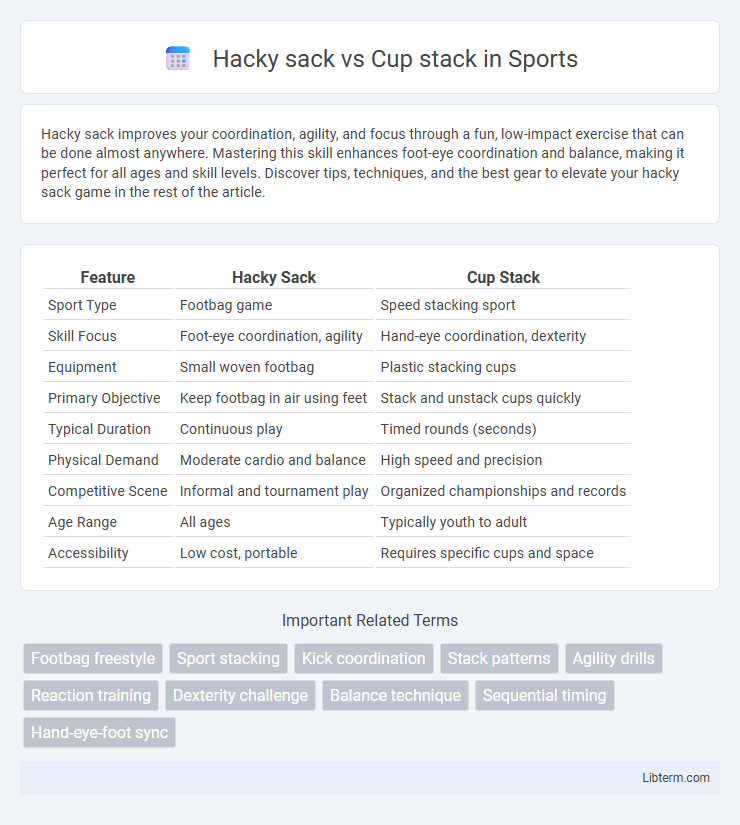Hacky sack improves your coordination, agility, and focus through a fun, low-impact exercise that can be done almost anywhere. Mastering this skill enhances foot-eye coordination and balance, making it perfect for all ages and skill levels. Discover tips, techniques, and the best gear to elevate your hacky sack game in the rest of the article.
Table of Comparison
| Feature | Hacky Sack | Cup Stack |
|---|---|---|
| Sport Type | Footbag game | Speed stacking sport |
| Skill Focus | Foot-eye coordination, agility | Hand-eye coordination, dexterity |
| Equipment | Small woven footbag | Plastic stacking cups |
| Primary Objective | Keep footbag in air using feet | Stack and unstack cups quickly |
| Typical Duration | Continuous play | Timed rounds (seconds) |
| Physical Demand | Moderate cardio and balance | High speed and precision |
| Competitive Scene | Informal and tournament play | Organized championships and records |
| Age Range | All ages | Typically youth to adult |
| Accessibility | Low cost, portable | Requires specific cups and space |
Introduction to Hacky Sack and Cup Stacking
Hacky sack is a footbag game involving continuous kicking and controlling a small, round bag using feet and other body parts to improve coordination, balance, and agility. Cup stacking, also known as sport stacking, requires stacking and unstacking specially designed cups in specific sequences at high speeds to enhance hand-eye coordination and concentration. Both activities serve as engaging physical exercises that develop fine motor skills and mental focus through repetitive and skill-based movements.
Origins and History of Each Sport
Hacky sack originated in the 1970s in Oregon, created by Mike Marshall and John Stalberger as a recreational footbag game to improve rehabilitation and coordination. Cup stacking was developed in the early 1980s by Wayne Godinet, who introduced the sport by creating uniform plastic cups designed for speed stacking competitions. Both sports emerged from grassroots movements emphasizing skill, coordination, and community engagement, but Hacky sack draws from traditional Asian footbag games while cup stacking evolved from competitive toy manipulation.
Equipment and Setup Differences
Hacky sack requires a small, soft, and flexible footbag typically filled with plastic pellets or sand, allowing easy control and manipulation during play. Cup stacking involves multiple specially designed plastic cups with holes that enable fast, stable stacking and unstacking sequences. The setup for hacky sack only requires an open, flat space, while cup stacking demands a flat surface for a precise stacking arrangement and often a timer for competitive play.
Gameplay Rules and Objectives
Hacky sack gameplay revolves around keeping a small, soft footbag airborne using any part of the body except hands, aiming to sustain continuous kicks without dropping it. In cup stack competitions, players stack and unstack a set of specialized plastic cups into predetermined pyramid shapes and then return them to a single stack at high speed. The primary objective in hacky sack is endurance and control, while cup stacking focuses on speed and precision in completing structured stacking sequences.
Physical and Mental Benefits
Hacky sack enhances physical coordination, balance, and leg strength through repetitive footwork, while stimulating mental focus and quick reflexes. Cup stacking improves hand-eye coordination, fine motor skills, and ambidexterity, promoting cognitive processing speed and concentration. Both activities support brain-body connection, fostering improved neural plasticity and stress relief.
Skill Development and Learning Curve
Hacky sack enhances foot-eye coordination, balance, and rhythmic timing through continuous footwork and controlled kicks, promoting fine motor skills in players. Cup stacking develops hand-eye coordination, ambidexterity, and concentration by requiring precise hand movements and quick sequential stacking patterns. The learning curve for hacky sack tends to be gradual as players build endurance and control, while cup stacking often allows for rapid initial skill gains but demands sustained practice for advanced speed and accuracy.
Competitive Scene: Tournaments and Communities
Hacky sack competitions feature fast-paced freestyle events judged on creativity, technical skill, and control, with leagues such as the Footbag Players Association hosting international tournaments. Cup stacking tournaments emphasize speed and precision, highlighted by the World Sport Stacking Association's organized events that attract players globally and foster strong local club communities. Both competitive scenes cultivate dedicated players and vibrant networks, but hacky sack leans on artistic expression while cup stacking prioritizes time-based performance metrics.
Social and Cultural Impact
Hacky sack fosters community interaction and physical coordination in informal outdoor settings, often linked to countercultural movements and promoting inclusivity across diverse age groups. Cup stacking cultivates concentration, dexterity, and competitive spirit in structured environments such as schools and clubs, highlighting teamwork and cognitive skill development. Both activities serve as social catalysts, enhancing interpersonal skills and cultural bonding through shared play and collaboration.
Accessibility and Popularity Worldwide
Hacky sack offers high accessibility due to minimal equipment and space requirements, making it popular in diverse settings worldwide from parks to schoolyards. Cup stacking demands specific plastic cups and a flat surface, slightly limiting its accessibility but gaining traction through competitive events and organized clubs internationally. Both activities enjoy widespread popularity, with hacky sack appealing to informal social play and cup stacking thriving in formal competitions and youth programs across numerous countries.
Which is Right for You: Hacky Sack or Cup Stacking?
Choosing between hacky sack and cup stacking depends on your goals: hacky sack improves foot-eye coordination, balance, and cardiovascular fitness through continuous kicking, while cup stacking enhances hand-eye coordination, speed, and cognitive processing by rapidly arranging and dismantling cup sequences. Hacky sack suits outdoor, rhythmic play and group socializing, whereas cup stacking fits indoor environments requiring minimal space and promotes quick reflexes and concentration. Assess your preferences for physical activity, space availability, and skill development to determine the ideal option for personal growth and enjoyment.
Hacky sack Infographic

 libterm.com
libterm.com